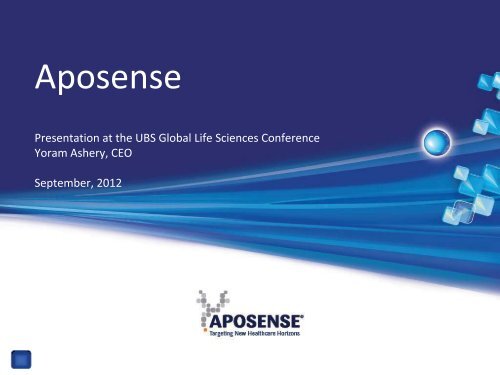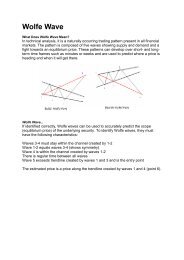Aposense Pipeline: From Platform to Products
Aposense Pipeline: From Platform to Products
Aposense Pipeline: From Platform to Products
Create successful ePaper yourself
Turn your PDF publications into a flip-book with our unique Google optimized e-Paper software.
<strong>Aposense</strong><br />
Presentation at the UBS Global Life Sciences Conference<br />
Yoram Ashery, CEO<br />
September, 2012
FORWARD LOOKING STATEMENTS<br />
The following slides contain forward-looking statements that include, but are not limited <strong>to</strong>, projections about our<br />
business and our future revenues, expenses and profitability. Forward-looking statements involve known and<br />
unknown risks, uncertainties and other fac<strong>to</strong>rs which may cause the actual events, results, performance,<br />
circumstances or achievements of the Company <strong>to</strong> be materially different from those expressed or implied by such<br />
forward-looking statements due <strong>to</strong> fac<strong>to</strong>rs that include, but are not limited <strong>to</strong>: (1) our ability <strong>to</strong> develop and bring <strong>to</strong><br />
market new products, (2) our ability <strong>to</strong> successfully complete any necessary or required pre-clinical and clinical<br />
studies with our products, (3) our ability <strong>to</strong> receive regula<strong>to</strong>ry clearance or approval <strong>to</strong> market our products or<br />
changes in regula<strong>to</strong>ry environment, (4) our success in implementing our sales, marketing and manufacturing plans,<br />
(5) the level of adoption of our products by medical practitioners, (6) the emergence of other products that may make<br />
our products obsolete, (7) protection and validity of patents and other intellectual property rights, (8) the effect of<br />
competition by other companies and technologies, and (9) our ability <strong>to</strong> obtain reimbursement for our products from<br />
government and commercial payers. You are cautioned not <strong>to</strong> place undue reliance on these forward-looking<br />
statements, which speak only as of the date of this slides. The Company undertakes no obligation <strong>to</strong> update any<br />
forward-looking statements, <strong>to</strong> report events or <strong>to</strong> report the occurrence of unanticipated events that may lead <strong>to</strong> the<br />
actual events, results, performance, circumstances or achievements of the Company being different than as<br />
envisaged by such forward looking statements.<br />
2
Apop<strong>to</strong>sis, a biological process involved in most diseases…<br />
<br />
<br />
<br />
<br />
<br />
<br />
Cell Apop<strong>to</strong>sis<br />
Programmed Cell Death<br />
3
A new paper every 25 minutes<br />
22,000<br />
No. of New Publication relating <strong>to</strong> Apop<strong>to</strong>sis, p per Year<br />
20,000<br />
18,000<br />
16,000<br />
14,000<br />
12,000<br />
10,000<br />
8,000<br />
6,000<br />
4,000<br />
2,000<br />
-<br />
1988<br />
1990<br />
1992<br />
1994<br />
1996<br />
1998<br />
2000<br />
2002<br />
2004<br />
2006<br />
2008<br />
2010<br />
* Based on Medline search
MISSION<br />
Translate Apop<strong>to</strong>sis <strong>to</strong> Patient Care<br />
Diagnosis, Treatment<br />
5
Mechanism of Action<br />
Membrane alterations trigger<br />
conformational and electric changes<br />
in switch moiety<br />
• A set of membrane alterations specific <strong>to</strong> the apop<strong>to</strong>tic cells identified<br />
• A molecular switch designed <strong>to</strong> respond <strong>to</strong> the apop<strong>to</strong>tic membrane<br />
changes<br />
Enables membrane anchoring and<br />
subsequent intra-cellular accumulation<br />
<strong>Aposense</strong> (fluorescent labeled)<br />
Preservation of<br />
membrane<br />
integrity<br />
Interfacial<br />
NanoSwitch<br />
Activation of the<br />
Phospholipid<br />
Scrambling System<br />
(PLS)<br />
Permanent<br />
depolarization of<br />
plasma<br />
membrane<br />
potential<br />
Acidification of<br />
external<br />
membrane leaflet<br />
Irreversible<br />
loss of<br />
cellular pH<br />
control<br />
Annexin V
Molecular Imaging<br />
First sight of disease<br />
US Market<br />
PET Radiopharmaceuticals<br />
2009 $358 million<br />
2017E<br />
$3,430 million<br />
Source: Bio-Tech Systems report 2010
Molecular Imaging of Apop<strong>to</strong>sis:<br />
Multiple Opportunities<br />
Oncology<br />
Treatment Moni<strong>to</strong>ring<br />
Neurology<br />
Cardio-vascular<br />
Acute MI<br />
Responder<br />
Non-Responder<br />
CT<br />
PET [ 18 F]-ML-10<br />
Vulnerable<br />
Plaque<br />
• Radiation<br />
• Chemo-Radiation<br />
• Chemotherapy<br />
• Targeted / Biologics<br />
• Stroke<br />
• Neuro-muscular disorders<br />
• Traumatic Brain Injury (TBI)<br />
• Multiple Sclerosis<br />
• Atherosclerosis (vulnerable plaque)<br />
• Acute MI<br />
• Heart Failure<br />
• Transplant rejection<br />
9
Molecular Imaging of Apop<strong>to</strong>sis:<br />
Clinical Development Program<br />
Phase 1<br />
Phase 2a Phase 2b Phase 3<br />
Healthy volunteers<br />
Stroke<br />
Brain metastases<br />
R 2 = 0.84 between<br />
EarliTest and MRI 6-8<br />
weeks after treatment<br />
Brain metastases<br />
Lung (NSCLC)<br />
Head & Neck<br />
Clinical Centers<br />
U.S. 11<br />
Israel 3<br />
France 2<br />
10
Molecular Imaging of Apop<strong>to</strong>sis:<br />
Phase 2: Design and Status<br />
CA004<br />
Brain<br />
metastases<br />
∆<br />
∆<br />
SRS<br />
24h<br />
8 weeks<br />
Diagnosis &<br />
Eligibility<br />
Baseline<br />
Ana<strong>to</strong>mical<br />
Imaging<br />
Baseline<br />
ML-10<br />
Imaging<br />
Treatment<br />
Follow-up<br />
ML-10<br />
Imaging<br />
Follow-up<br />
Ana<strong>to</strong>mical<br />
Imaging<br />
1w<br />
Combined Chemo-Radiation<br />
7 weeks<br />
8 weeks<br />
CA007<br />
H&N and<br />
NSCLC<br />
∆<br />
∆<br />
Timeline<br />
CA004 Brain metastases treated with SRS<br />
Recruitment<br />
Completed<br />
CA007 H&N treated with chemo-radiation Oc<strong>to</strong>ber 2012<br />
CA007 Lung treated with chemo-radiation Postponed, image<br />
analysis<br />
Results<br />
November 2012<br />
February 2013<br />
Safety status:<br />
212 procedures<br />
106 patients<br />
No related<br />
adverse event<br />
Forward-Looking Information Notice: The Company’s assessments and estimates regarding the above timeline depend,<br />
among other fac<strong>to</strong>rs, on continuation of present patient recruitment rate, sufficient clinical data and successful clinical trials<br />
results analysis, and other risk fac<strong>to</strong>rs which apply <strong>to</strong> the Company’s activity, as described on Company’s annual reports
Commercialization Partner<br />
World’s widest PET radio-pharmacy network<br />
Labeling & Distribution<br />
• IBA <strong>to</strong> distribute radio-labeled ML-10 ready <strong>to</strong> inject<br />
• Global coverage with specific timelines<br />
12
<strong>Aposense</strong> ®<br />
Targeted<br />
Therapy<br />
(ATT)
N<br />
Targeting apop<strong>to</strong>sis<br />
Extending pharmaco-kinetics<br />
Selective activation on target<br />
Overcoming cancer cell resistance<br />
Oral administration<br />
<strong>Aposense</strong> ®<br />
Active Drug<br />
New Drug<br />
14
ATT-11T<br />
Irinotecan, SN-38<br />
Topoisomerase<br />
Conjugate<br />
Approved<br />
indications<br />
SN-38, the active metabolite of irinotecan<br />
(Camp<strong>to</strong>sar®, Pfizer)<br />
• metastatic colon cancer (US, EU)<br />
• small cell lung cancer (Japan)<br />
Also shown activity in ovarian and other<br />
gastrointestinal cancers<br />
Commercial<br />
Status<br />
Patent expired 2008/9<br />
Pre-expiration sales >$1.0B<br />
Mechanism<br />
Inhibits Topoisomerase I<br />
Topoisomerase I inhibition<br />
Limitations<br />
Toxicity<br />
Short half-life<br />
IV administered
ATT-11T: Prolonging SN-38 Half-life<br />
SN-38 half-life when released from ATT-11T is >5X longer<br />
Active moiety (SN-38) in ATT-11T compared <strong>to</strong> Irinotecan (dog study)<br />
Concentration, ng/mL (log scale)<br />
10.0<br />
1.0<br />
0.1<br />
0.0<br />
* Not detectable<br />
Slow<br />
Clearance<br />
ATT-11T<br />
irinotecan<br />
* *<br />
0 4 8 12 16 20 24 28 32 36 40 44 48<br />
t 1/2 (hr)<br />
14<br />
12<br />
10<br />
8<br />
6<br />
4<br />
2<br />
0<br />
SN-38 derived from ATT-11T vs. Irinotecan X5.2<br />
12.1<br />
2.3<br />
irinotecan<br />
ATT-11T<br />
Results reproduced in additional studies<br />
16
ATT-11T is >13X More Selective <strong>to</strong> Tumor<br />
Bio-distribution studies in A375 bearing mice; concentration of SN38 (active metabolite) in Tumor and Muscle<br />
ng/gr*hr<br />
(AUC)<br />
4000<br />
3000<br />
3855<br />
Tumor<br />
Tumor/Muscle Selectivity Ratio<br />
2000<br />
1000<br />
0<br />
ATT-11T<br />
1153<br />
Irinotecan<br />
200<br />
160<br />
120<br />
200<br />
ng/gr*hr<br />
(AUC)<br />
80<br />
Muscle<br />
80<br />
40<br />
14.8<br />
60<br />
40<br />
78<br />
0<br />
ATT-11T<br />
Irinotecan<br />
20<br />
0<br />
19.2<br />
ATT-11T<br />
Irinotecan
ATT-11T showed superior efficacy<br />
Melanoma<br />
Model A375<br />
Ovarian Carcinoma<br />
Model OVCAR<br />
Tumor size (mm 3 )<br />
4000<br />
Human<br />
3500 melanoma<br />
implanted in<br />
3000 mice<br />
Non-Treated<br />
(Control group)<br />
Irinotecan<br />
(75 X 3 mg)<br />
Tumor size (mm 3 )<br />
Control-vehicle<br />
1000<br />
CPT-11 3x18mg/kg<br />
900<br />
ATT-11T 3x20mg/kg<br />
800<br />
Non-Treated<br />
(Control group)<br />
Irinotecan<br />
(3 X 18 mg)<br />
2500<br />
2000<br />
700<br />
600<br />
500<br />
1500<br />
400<br />
1000<br />
500<br />
0<br />
10 15 20 25 30 35 40 45 50 55 60<br />
ATT-11T<br />
(5 X 9 mg)<br />
300<br />
200<br />
100<br />
0<br />
ATT-11T<br />
(3 X 20 mg)<br />
1 3 5 7 9 11 13 15 17 19 21 23 25 27 29 31 33 35 37 39 41<br />
Tx End<br />
Tx End
ATT-11T Preliminary Safety<br />
MTD studies: daily administration in rats (n=3 per group); no <strong>to</strong>xicity observed<br />
Weight<br />
(% from<br />
baseline)<br />
110<br />
105<br />
100<br />
ATT-11T, 200 mg/Kg, PO<br />
95<br />
90<br />
85<br />
80<br />
Irinotecan, 90 mg/Kg, IP<br />
75<br />
70<br />
1 2 3 4 5<br />
Days<br />
Irinotecan<br />
ATT-11T<br />
Weight at day 5(%) 77-96 99-102<br />
Diarrhea 2 / 3 None
TEVA agreement<br />
• TEVA collaboration: generic cy<strong>to</strong><strong>to</strong>xics conjugated <strong>to</strong> <strong>Aposense</strong>® molecule (2005)<br />
• TEVA <strong>to</strong> invest up <strong>to</strong> $11M<br />
• $2M in equity, up <strong>to</strong> $9M in development (after <strong>Aposense</strong> invests $2M)<br />
• Economics<br />
After Teva’s full investment, <strong>Aposense</strong> <strong>to</strong> choose between:<br />
• 7% royalty<br />
• 32% share in proceeds and participate in 25% of costs; and<br />
• 50% share in proceeds and costs<br />
• IND 2013 (updated)<br />
Forward-Looking Information Notice: The Company’s assessments and estimates<br />
regarding the above timeline depend, among other fac<strong>to</strong>rs, on continuation of present patient<br />
recruitment rate, sufficient clinical data and successful clinical trials results analysis, and other<br />
risk fac<strong>to</strong>rs which apply <strong>to</strong> the Company’s activity, as described on Company’s annual reports
ATT-GEM<br />
Conjugate<br />
Approved<br />
Indications<br />
(solid<br />
tumors)<br />
Commercial<br />
Status<br />
Mechanism<br />
Limitations<br />
Gemcitabine (Gemzar®, Eli Lilly)<br />
Pancreas<br />
Bladder<br />
Lung (NSCLC)<br />
Breast<br />
Ovarian<br />
Patent expired 2010-2013<br />
Peak sales $1.72B (2008)<br />
Blocking DNA synthesis<br />
Tumor resistance (cellular uptake<br />
is depends on hENT-1)<br />
Short half-life (32-94 minutes)<br />
Toxicity (neutropenia)<br />
IV administration<br />
Resistant<br />
Source: Spratlin et al. Clin Can Res (2004)<br />
Responsive
ATT-GEM potent in resistant cells<br />
hENT-1 inhibited K562 cells<br />
Growing cells (% of control)<br />
100<br />
80<br />
60<br />
40<br />
20<br />
0<br />
100<br />
80<br />
60<br />
40<br />
20<br />
0<br />
Resistant<br />
cells<br />
0 0.2 0.4 0.6 0.8 1<br />
Resistant<br />
cells<br />
0 0.2 0.4 0.6 0.8 1<br />
DP (Dipyridamole), 10μM for 30min<br />
Incubation time with the drug: 72h<br />
GEM<br />
GEM+DP<br />
TBE-es ATT-GEM2<br />
TBE-es+DP<br />
ATT-GEM2+DP<br />
GEM<br />
GEM+DP<br />
Tes ATT-GEM1<br />
Tes+DP ATT-GEM1+DP<br />
90<br />
80<br />
70<br />
60<br />
50<br />
40<br />
30<br />
20<br />
10<br />
0<br />
Resistant index =<br />
0.8<br />
4.7<br />
IC50 (*) Resistant<br />
IC50 Normal<br />
ATT-GEM1 ATT-GEM2 Gemcitabine<br />
* IC50 = concentration<br />
required <strong>to</strong> kill 50% of cells<br />
83<br />
CONFIDENTIAL
ATT-GEM<br />
Initial in-vivo performance data in responding (sensitive) tumor<br />
(HCT116 colon carcinoma)<br />
Similar efficacy in responsive tumors, with safety benefit<br />
Weight (% of control)<br />
Tumor growth inhibition<br />
115<br />
2000<br />
Control<br />
110<br />
105<br />
100<br />
1800<br />
1600<br />
1400<br />
1200<br />
Gemcitabine 50mg<br />
Gemcitabine 100mg<br />
ATT-GEM1 120mg<br />
ATT-GEM2 120mg<br />
95<br />
1000<br />
800<br />
90<br />
600<br />
85<br />
400<br />
80<br />
0 5 10 15 20 25 30<br />
200<br />
0<br />
0 5 10 15 20 25 30
ATT-LD<br />
Long-acting levodopa for treatment of Parkinson’s disease<br />
Parkinson’s<br />
disease<br />
Progressive neuro-degenerative disorder, caused<br />
by depletion of the neuro-transmitter dopamine<br />
Prevalence 1.4 million (US, 5 EU and JP)<br />
Levodopa (L-Dopa) mainstay treatment of<br />
moderate-advanced PD<br />
Mechanism<br />
Precursor of dopamine<br />
Key Limitations<br />
Short half-life (45-90 minutes)<br />
Absorbed mainly in the duodenum, only 5-10%<br />
reaches the brain
The short half-life problem
ATT-LD Significantly Extends Levodopa Formation<br />
Rat model; concentration levels under effective range (should be increased)<br />
500<br />
450<br />
5 hrs steady levodopa formation<br />
PO 45mg/kg 7M<br />
PO 180mg/kg 8M<br />
400<br />
350<br />
Levodopa, ng/ml<br />
300<br />
250<br />
200<br />
150<br />
100<br />
50<br />
0<br />
0 60 120 180 240 300 360 420 480<br />
Time, min<br />
* Levodopa T ½ in rat 42-48 minutes
<strong>Pipeline</strong><br />
Molecular Imaging<br />
Discovery Pre-Clinical Phase 1 Phase 2 Phase 3<br />
ML-10<br />
Apop<strong>to</strong>sis Imaging<br />
Therapeutic<br />
Oncology<br />
ATT-11<br />
ATT-GEM<br />
CRC, Esophageal, SCLC<br />
Pancreatic cancer<br />
Neurology<br />
ATT-LD<br />
Parkinson’s Disease
New Product Initiation Process<br />
Identify unmet<br />
clinical needs<br />
Select active<br />
therapeutic<br />
Apply <strong>Aposense</strong>®<br />
technology <strong>to</strong> create<br />
a new drug that<br />
addresses the need<br />
R&D
Discovery<br />
In Vivo<br />
In Vitro<br />
• Medicinal chemistry<br />
• Rational drug design<br />
• Molecular modeling<br />
• Synthesis via network of contrac<strong>to</strong>rs<br />
• Fully equipped biochemistry lab<br />
• Licensed radioactive suite for β<br />
emitters<br />
• Cancer cell lines bank<br />
• Established apop<strong>to</strong>sis models<br />
• Cy<strong>to</strong><strong>to</strong>xic drug handling<br />
• Cell culture<br />
unit<br />
• Animal house,<br />
wild type species<br />
and immune<br />
deficient mice<br />
• An array of established<br />
xenograft mice models<br />
• In-house his<strong>to</strong>logy unit for sectioning<br />
and various staining techniques with<br />
<strong>to</strong>p tier his<strong>to</strong>pathologists consultancy<br />
• Expertise in IV and oral formulations,<br />
including poorly soluble drugs<br />
• CRO network for formal pre-clinical<br />
development, PK/PD, oralbioavailability,<br />
ADME and<br />
<strong>to</strong>xicology studies<br />
• In-house management of<br />
CMC via contrac<strong>to</strong>rs<br />
Final<br />
Drug Product
Financial Information<br />
Shareholder Base<br />
Cash position:<br />
$25.3 million<br />
(June 30, 2012)<br />
11%<br />
31%<br />
Cash used for operations:<br />
FY2010<br />
FY2011<br />
Jun 30, 2012<br />
$5.5 million<br />
$6.7 million<br />
$3.8 million<br />
21%<br />
4%<br />
14%<br />
20%<br />
Private Investment Firms<br />
Public Listing:<br />
TASE: APOS<br />
Venture Capital<br />
Financial Institutions (≥5%)<br />
Big Pharma<br />
Direc<strong>to</strong>rs, Officer & Employees<br />
Public, Institutions (
Summary<br />
• Core Core Capabilities<br />
Capabilities<br />
– Novel platform technologies<br />
– Full drug development capabilities<br />
– New Product Generation Process<br />
• <strong>Pipeline</strong><br />
<strong>Pipeline</strong><br />
– Lead clinical program: Apop<strong>to</strong>sis Imaging (ML-10) near completion of phase 2<br />
– Growing & maturing pre-clinical portfolio: 3 new drugs, major unmet needs<br />
– New compounds continuously added by application of platform<br />
• Corporate Infrastructure<br />
– Experienced board and management team<br />
– Strong financial position
Thank you.





